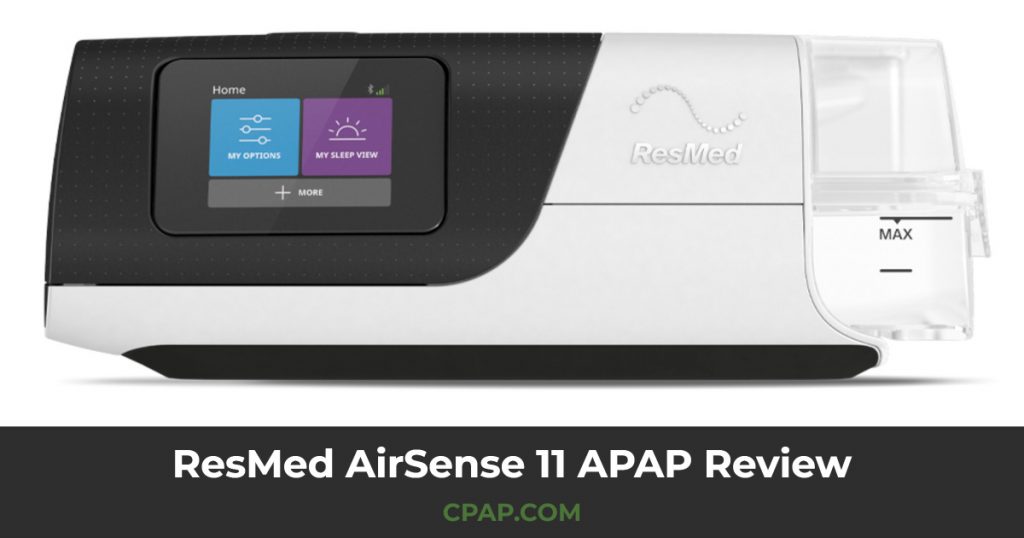
Launched in the second half of 2021, ResMed’s AirSense™ 11 AutoSet™ has been under a fair bit of scrutiny as it seeks to live up to its predecessor, the widely acclaimed AirSense™ 10 AutoSet™.
In this AirSense 11 review, we’ll take a look at everything that’s changed and share why we think this device is a fantastic option for anyone looking to buy their first CPAP machine.
We’ll also explore some feedback from the CPAP community and answer some frequently asked questions about the AirSense 11 that we have been seeing. Most importantly, we’ll be pitting the AirSense 11 vs AirSense 10 to highlight the pros and cons of each so you can make the most informed decision when choosing your next machine.
If you’ve recently been diagnosed with sleep apnea or are looking to upgrade and replace your existing machine with one of the best new CPAP machines on the market, then we have you covered! Keep reading to dive into our AirSense 11 review and comparison below.
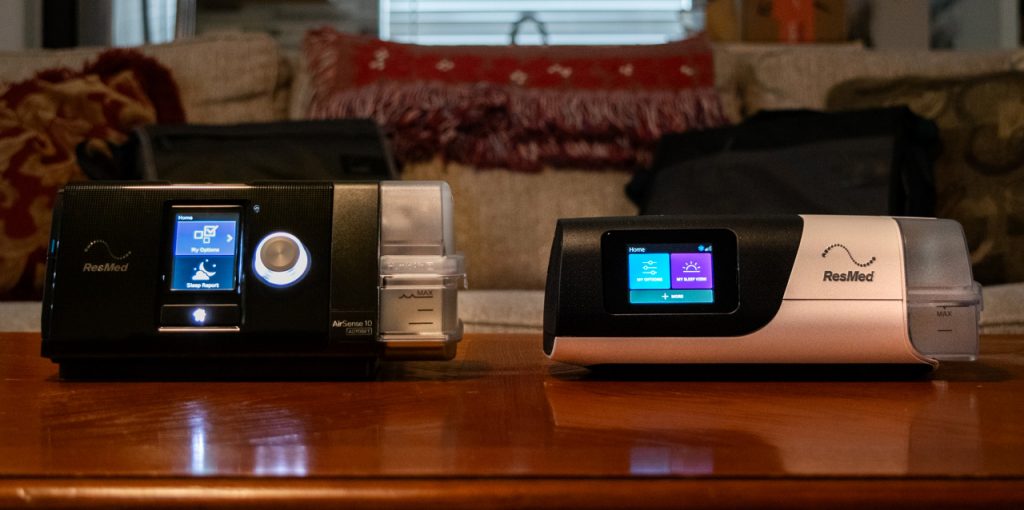
ResMed AirSense 11 Design Changes and New Features
For the sake of simplicity, let’s start with some of the more physical changes with the AirSense 11:
- Sound Output: On paper, the AirSense 11 is slightly noisier at 27 decibels compared to the AirSense 10’s 26.6 decibels. However, in practice, the difference between the sound levels of these machines is realistically not noticeable, and both are considered to be among the quietest CPAP machines.
- Size and Weight: The AirSense 11 is 0.25 lbs lighter, nearly a half-inch shallower, nearly a half-inch shorter, and just under 1/5th of an inch longer than the AirSense 10. The difference in length is barely noticeable, but the other differences are definite improvements over the previous design.
- Redesigned Water Chamber: The AirSense 11’s new humidifier chamber holds the same amount of water as the previous generation with a shorter height and broader base. It is not compatible with the AirSense 10, nor is the AirSense 10’s water chamber compatible with the AirSense 11.
- Navigation and Display: The AirSense 11 ditched the scroll dial and home button from the AirSense 10 in favor of full-touchscreen operation. Both machines have an easily accessible “Therapy Start” button atop the device, and both feature an auto-dimming color LCD screen.
- New Power Supply: The AirSense 11 features a sleeker and more energy-efficient 65W power supply as an update to the clunkier 90W power supply provided with the AirSense 10.
- Tubing: Both the AirSense 11 and AirSense 10 Card-to-Cloud include ResMed SlimLine Tubing, while the AirSense 10 Connected ships with premium ClimateLineAir Heated Tubing. AirSense 10 units also include a 90° hose elbow, which does not come with the AirSense 11.
- General Design: Visually, the AirSense 11 feels much sleeker and more modern than the AirSense 10.
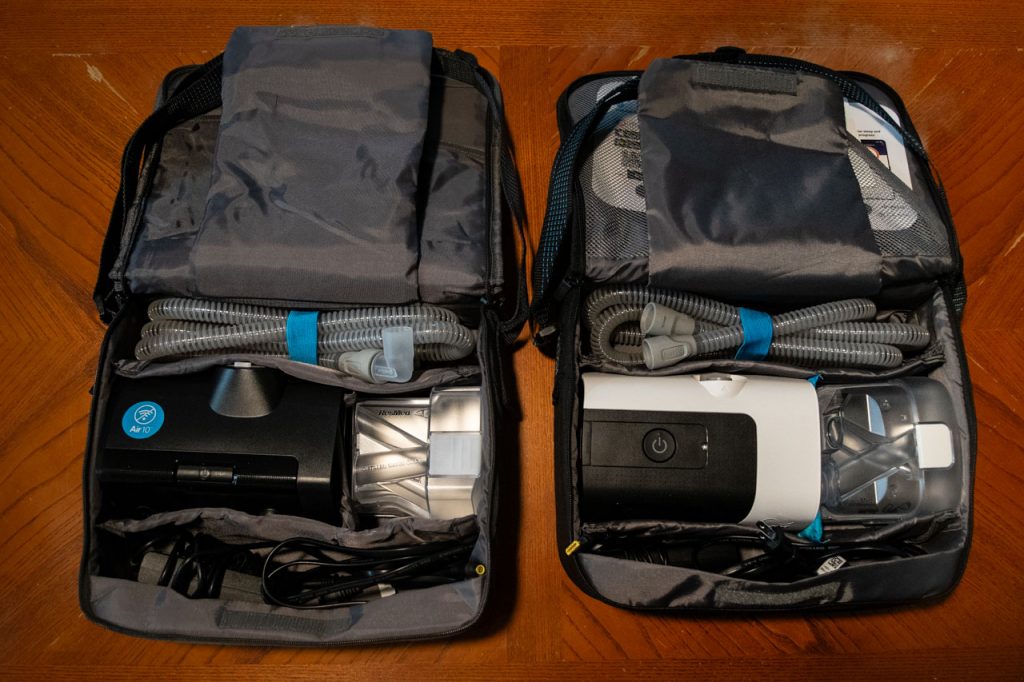
AirSense 11 Software Changes and Exclusive Features:
- Redesigned Menu System: The AirSense 11 features a redesigned menu system that makes it easier to navigate and make therapy adjustments with just the tap of a finger.
- Exclusive Features: AirSense 11 owners can enjoy exclusive new features like:
- Test Drive: This feature lets you get more comfortable with your machine and experience a range of pressure settings.
- Personal Therapy Assistant: This is a series of voice-guided videos designed to help you set your machine up and start therapy successfully. This feature is available in the myAir companion app (iOS and Android).
- Care Check-In: Care Check-In will ask you questions about how you’re acclimating to your therapy every week during the first 30 days and offer tailored support and troubleshooting tips as needed.
- Automatic Software Updates: The AirSense 11 will stay up-to-date with the latest bug fixes, security updates, and new features from ResMed whenever it has a cellular network connection.
- Integrated For Her Algorithm: The AirSense 11 integrated the For Her breathing algorithm that was previously only available with the separate AirSense 10 AutoSet For Her model. The algorithm is tailored towards women’s breathing patterns for more personalized therapy.
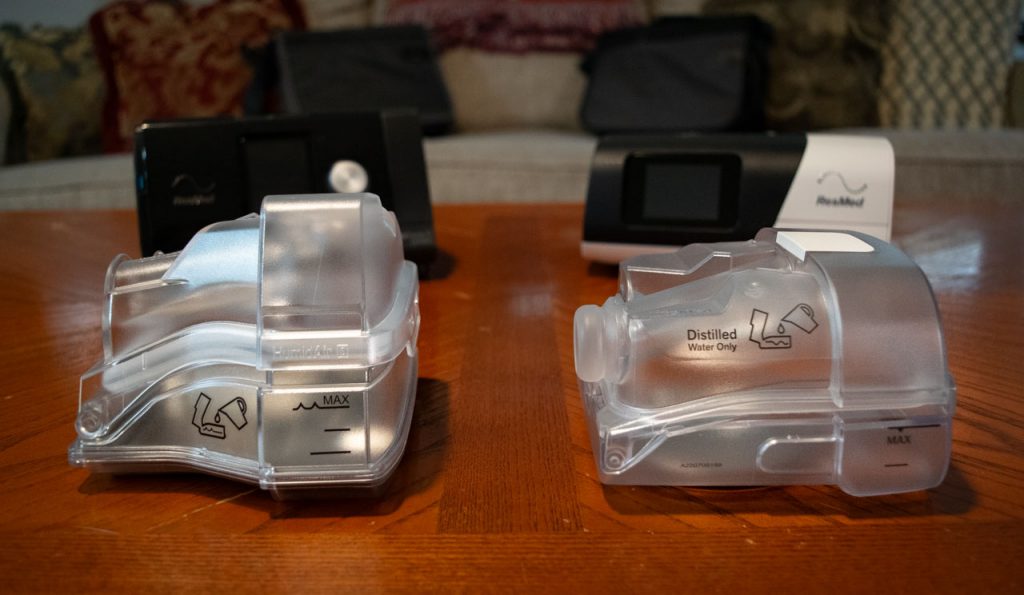
ResMed AirSense 11 vs AirSense 10: How Do These ResMed Machines Compare?
With the revival of ResMed’s AirSense 10 Connected, it’s more confusing than ever to navigate the differences between the three main offerings in ResMed’s machine catalog.
To help clear things up, here’s a comparison table of both versions of the ResMed AirSense 10 vs AirSense 11:
| Features and Specs | AirSense 11 AutoSet | AirSense 10 AutoSet Connected | AirSense 10 AutoSet Card-to-Cloud |
| Sound Level | 27 dBA | 26.6 dBA | 26.6 dBA |
| Weight | 2.5 lbs | 2.75 lbs | 2.75 lbs |
| Size (Machine Only) | 10.21″ x 3.72″ x 5.45″ | 10.04″ x 4.57″ x 5.91″ | 10.04″ x 4.57″ x 5.91″ |
| Power | 65W AC Adapter | 90W AC Adapter | 90W AC Adapter |
| Max Operating Altitude | 9870 ft | 8500 ft | 8500 ft |
| AutoSet for Her | Built-In Algorithm | Separate Machine | Separate Machine |
| Heated Tubing | Optional | Included | Optional |
| Pressure Range | 4-20 cmH2O | 4-20 cmH2O | 4-20 cmH2O |
| Data Tracking | Wireless (Cellular) | Wireless (Cellular) | SD-Card-Only |
| Built-In Heated Humidifier | ✓ | ✓ | ✓ |
| Ramp & EPR | ✓ | ✓ | ✓ |
| Battery Backup Available | ✓ | ✓ | ✓ |
| Smart Start/Stop | ✓ | ✓ | ✓ |
| Care Check-In | ✓ | X | X |
| Personal Therapy Assistant | ✓ | X | X |
| Test Drive | ✓ | X | X |
| Bluetooth® Connectivity | ✓ | ✓ | X |
| Over-the-Air Software Updates | ✓ | ✓ | X |
AirSense 11 Video Review
Should You Upgrade to the AirSense 11 if You Already Have the AirSense 10?
While this isn’t a revolutionary re-design, ResMed has taken the best features of the AirSense 10 and improved upon them. If this is your first time purchasing a CPAP device, the AirSense 11 is definitely worth considering as it is designed with new users in mind.
However, if you are looking for a budget-friendly option, the ResMed AirSense 10 Card-to-Cloud is arguably the best-priced CPAP machine on the market right now if you don’t care too much about keeping a close eye on your therapy data or reporting compliance metrics.
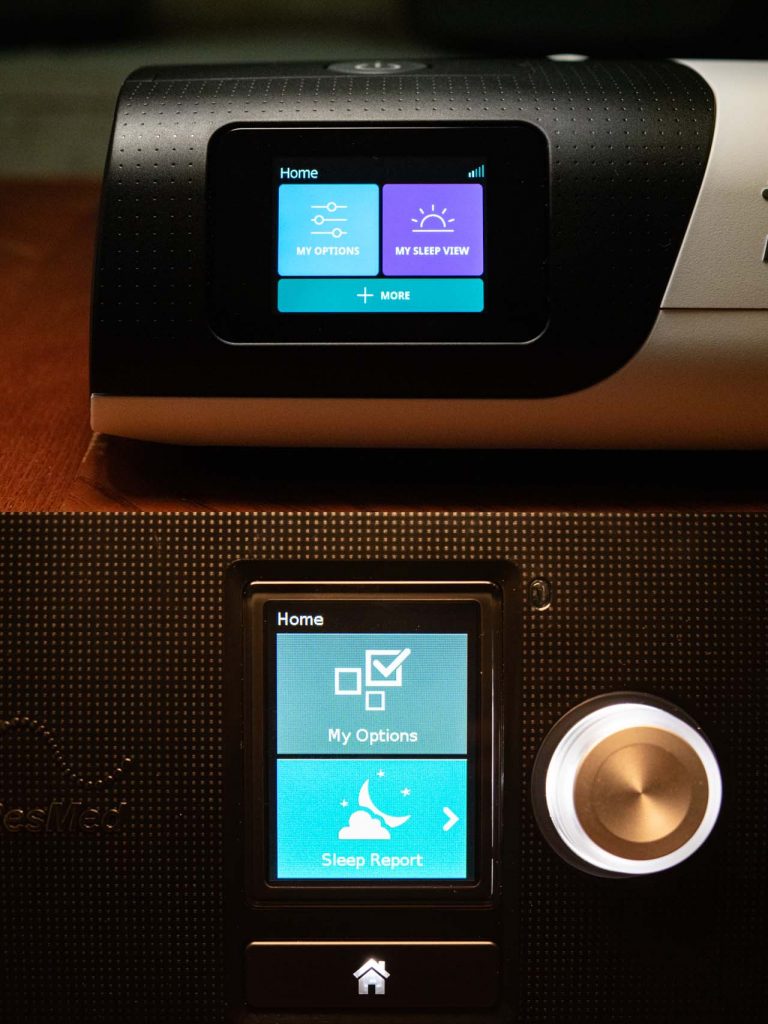
Where To Buy the AirSense 11
The ResMed AirSense 11 is currently available to purchase on cpap.com. Visit our ResMed CPAP Machine page to compare ResMed Machines.
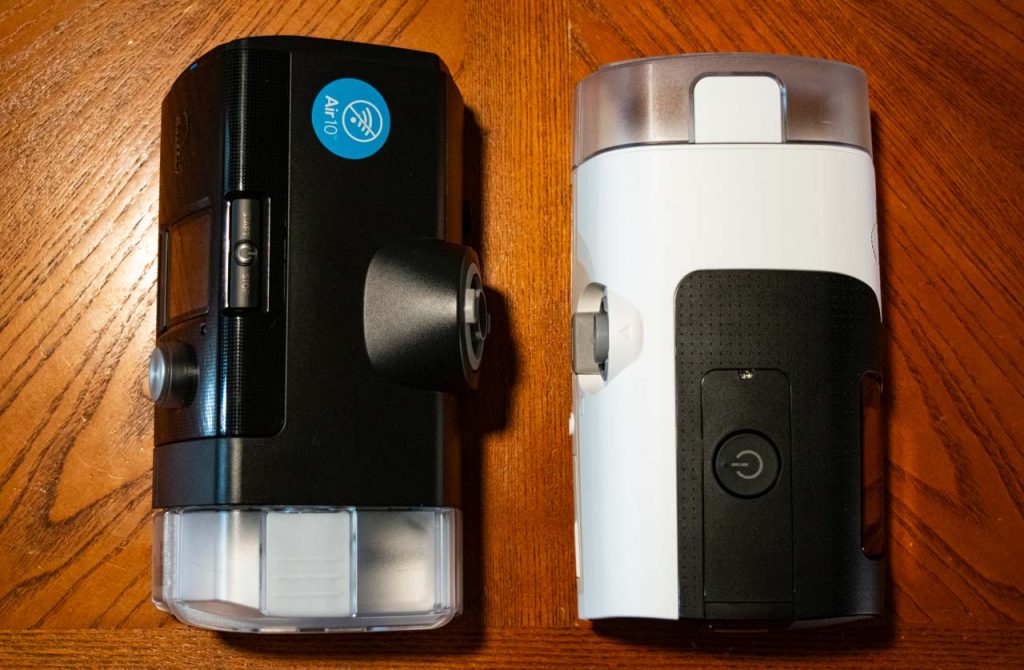
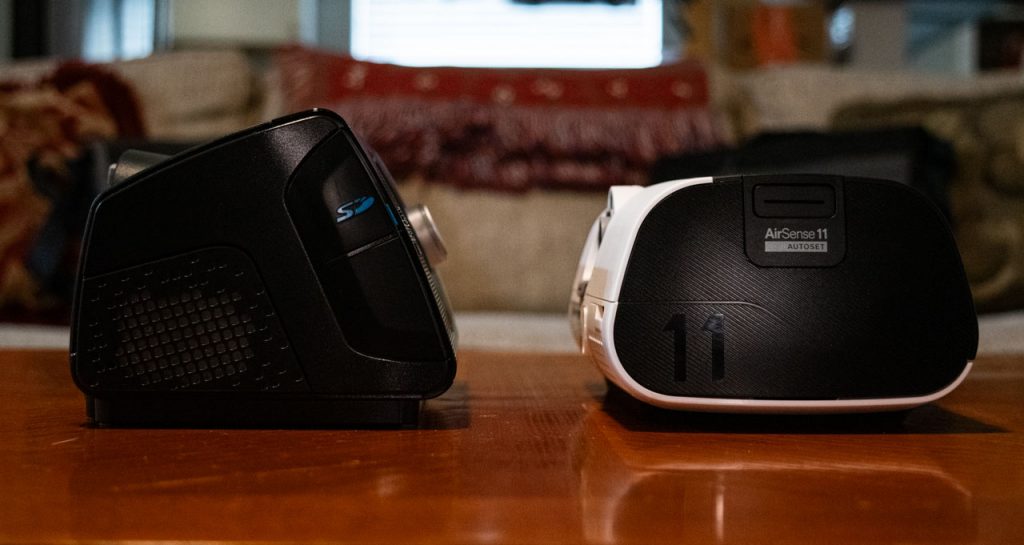
Feedback and Frequently Asked Customer Questions
To better address questions, comments, and concerns about the AirSense 11, we’ve collected feedback from our Facebook page as well as from others in the CPAP community. Here’s what people have been saying and asking so far:
1. Can I Use AirSense 11 Without a Humidifier?
You can use your AirSense 11 without a humidifier by navigating to your Humidity Level settings and turning it to “Off”. The chamber or optional side cover must be installed for the device to function, so be sure to empty any water from the tub as well.
2. How Loud Is the ResMed AirSense 11?
The ResMed AirSense 11 registers at just 27 decibels during operation, making it one of the quietest CPAP machines available.
3. Can AirSense 11 Connect to WiFi?
No. The AirSense 11 features Bluetooth compatibility to connect to the mobile MyAir smartphone app, but utilizes cellular data for Over-the-Air Software Updates and therapy data uploads to ResMed’s AirView Cloud service.
4. Can I Use My ResMed AirSense 11 Without Water?
You can use your AirSense 11 without water by emptying your humidifier chamber, navigating to your Humidity Level settings, and turning your humidifier to the “Off” setting. The humidifier chamber or optional side cover accessory must be connected for the device to work properly. For more information, read our AirSense 11 Troubleshooting article.
5. Does AirSense 11 Have Smart Start?
Yes, the AirSense 11 features SmartStart technology, which automatically detects breathing and begins therapy when you put your mask on.
6. Does the AirSense 11 Turn Off Automatically?
Yes, the AirSense 11 features SmartStop technology, which will automatically stop delivering therapy a few seconds after you remove or disconnect from your mask.
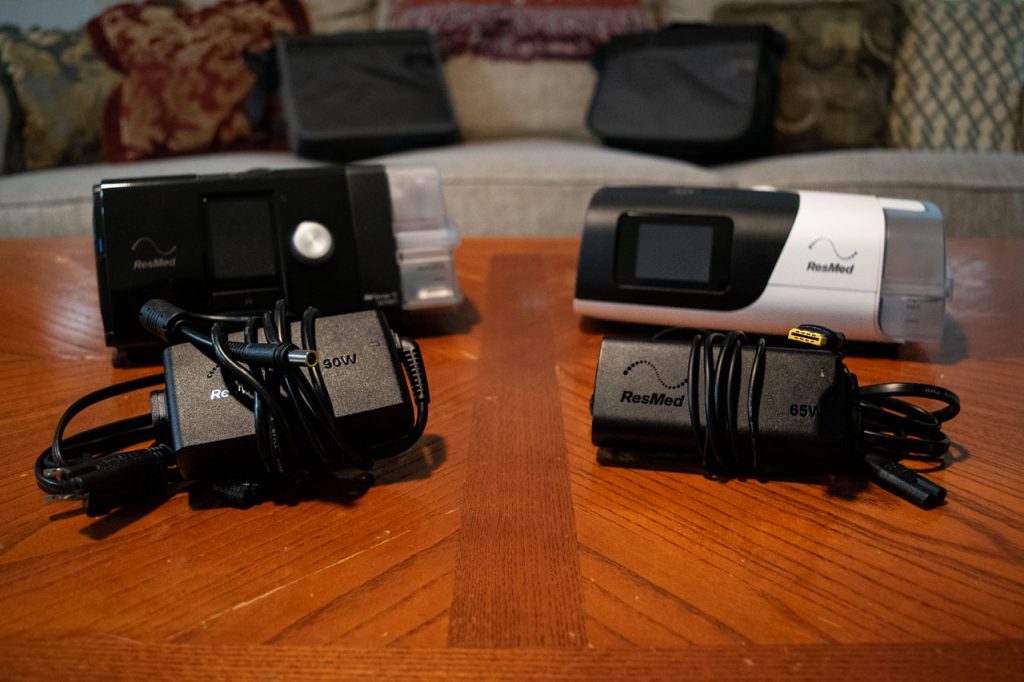
7. Does AirSense 11 Have Airplane Mode?
Yes, the AirSense 11’s Airplane Mode feature allows you to conveniently disable and re-enable data transfers after therapy or during travel. Simply tap “MORE” from the home screen, then swipe through the menu to find and enable or disable Airplane Mode.
8. Does ResMed AirSense 11 Have an SD Card?
The ResMed AirSense 11 features an SD card slot for convenient data tracking on your device. It also wirelessly transmits therapy data to ResMed’s AirView Cloud service for viewing on your MyAir companion app.
9. Does ResMed AirSense 11 Have a Battery?
Battery options are somewhat limited for the AirSense 11 until ResMed releases a DC power adapter, but CPAP batteries with standard AC outlets will power the AirSense 11. Any Zopec Explore Battery or the Portable Outlet UPS Battery are ideal because they can be used as a backup battery during a power outage. When connected between your CPAP machine and a wall outlet, a backup battery will automatically switch to battery power when the power goes out, ensuring you don’t miss a beat of your CPAP therapy.
10. Is There a Replacement Hose for the AirSense 11?
Any standard hose will work with the AirSense 11, and ResMed’s SlimLine Tubing (what’s included with your AirSense 11) or ClimateLineAir™ 11 Heated Tube can be purchased separately. When you connect a ClimateLineAir Heated Tube to your AirSense 11, your machine gains access to the Automatic Climate Control Function, ensuring that you always have the perfect temperature and humidification with no rainout.
11. Can I Use the AirSense 10 Water Chamber, or Is There a New One Available for the AirSense 11?
The AirSense 10 and AirSense 11 water reservoirs are not interchangeable. With a replacement schedule of every 6 to 12 months or when it starts to show signs of wear and tear, ResMed’s Standard Water Chamber for AirSense™ 11 Humidair™ Heated Humidifier is available to be purchased separately if the included water chamber becomes damaged or needs to be replaced.
12. Are There Replacement Filters Available for the New AirSense 11 Machine?
For the air quality you’ve come to know and love, you can purchase replacement filters for the AirSense 11 on our website, including Disposable Hypoallergenic Filters and Disposable Standard Filters.
13. Does the AirSense 11 Support a Two-Filter Setup?
While the AirSense 11 only uses a single disposable filter, a hypoallergenic filter option is available for more protection from small airborne allergens for those who have frequent allergies, including those who are sensitive to polyester.
Final Thoughts
ResMed’s AirSense 11 builds off the success of the much loved AirSense 10 while considering new users and customer feedback, excelling the AirSense 11 to the next level. With the added software improvements, integrated For Her version, and therapy tracking innovations, the ResMed AirSense 11 is a competent choice whether you’re new to CPAP or picking out a replacement machine!



